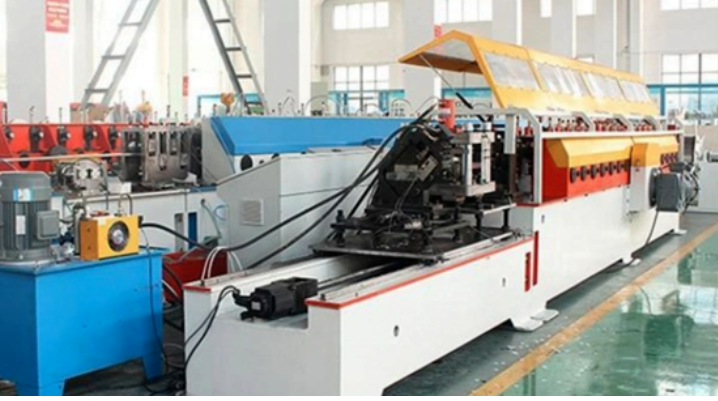
Posted on Saturday, October 5, 2024
Automation is transforming industries across the globe, and the roll forming sector in the U.S. is no exception. As the demand for metal components grows, especially in construction, automotive, and renewable energy sectors, U.S. manufacturers are increasingly turning to automated roll forming machines to enhance production efficiency, ensure precision, and reduce labor costs. This blog explores the ways in which automation in roll forming is benefiting U.S. manufacturers, making them more competitive in an evolving marketplace.
One of the most significant advantages of automation in roll forming machines is the dramatic increase in production speed. Traditional roll forming required manual input at multiple stages, slowing down the process and leaving room for human error. Automated roll forming machines, however, streamline the process from material feeding to the final cut, allowing manufacturers to produce metal profiles at high speeds. This efficiency is crucial for U.S. manufacturers that need to meet tight deadlines, especially in sectors like commercial construction and infrastructure development, where large volumes of components are required quickly.
Automation also improves precision in roll forming, ensuring consistent output quality across long production runs. Roll forming machines equipped with computerized control systems can be programmed to produce exact specifications for metal profiles, leaving little room for variance. This precision is vital in industries like automotive and aerospace, where even minor discrepancies in component dimensions can cause major issues. Automated roll forming ensures each piece meets stringent quality standards, reducing the need for rework or waste.
Another key benefit of automation in roll forming is the reduction of manual labor, which not only cuts costs but also minimizes human error. U.S. manufacturers are facing increasing pressure to reduce labor costs while maintaining high output levels. Automated roll forming systems require fewer operators and can work continuously with minimal intervention, allowing companies to allocate human resources to more complex tasks that require critical thinking. This also helps companies mitigate the impact of labor shortages, which have become a growing concern in manufacturing.
With automation, manufacturers can better optimize material usage, further driving down costs. Automated systems can measure material input and make real-time adjustments to minimize waste. For example, a roll forming machine with an integrated coil handling system can ensure that coils are used to their maximum potential, reducing scrap and leftover material. This is especially important in industries that rely on high-quality metals like steel or aluminum, where raw material costs are a significant portion of the total manufacturing expense.
Automation also enhances workplace safety, a critical concern for U.S. manufacturers. By reducing the need for manual intervention in the roll forming process, automated systems keep workers away from potentially hazardous machinery. Many modern roll forming machines include safety features like automated shutdown systems that activate if the machine detects a malfunction. This minimizes the risk of accidents and injuries, contributing to a safer manufacturing environment.
Automation in roll forming is paving the way for smart manufacturing in the U.S. Advanced machines now come with integrated data collection systems that allow manufacturers to monitor production in real-time. This data can be analyzed to identify inefficiencies, optimize machine settings, and even predict maintenance needs before breakdowns occur. As U.S. manufacturers continue to adopt Industry 4.0 technologies, the integration of roll forming machines with IoT devices and cloud-based software will further enhance production capabilities and decision-making.
The role of automation in roll forming is undeniable. For U.S. manufacturers, automated roll forming machines are key to increasing production speed, ensuring consistent quality, and reducing labor and material costs. As industries demand more efficiency, precision, and sustainability, automation will continue to drive innovation in the roll forming sector, helping U.S. manufacturers stay competitive in an increasingly global market.
4o

Understanding Coil IDs, Mandrel Sizing, and Shear Pin Safety in Uncoilers
Posted on Wednesday, October 1, 2025
Mismatched sizes can lead to machine damage, downtime, and safety hazards — often evidenced by a shear pin failure.

How Coil Tensile Strength Affects Roll Forming and How to Adjust Your Machine
Posted on Wednesday, October 1, 2025
Changes in tensile strength can significantly affect the finished profile, causing misaligned bends, uneven edges, and out-of-spec parts.

Why Paint Cracks on an Embossing Line Running Pre-Painted Coil and How to Prevent It
Posted on Wednesday, October 1, 2025
This issue not only affects the visual quality of the product but can also lead to increased scrap rates and customer complaints.

The Most Popular Standing Seam Metal Roof Panels in the U.S. — A Comprehensive Guide
Posted on Monday, September 29, 2025
In this post, we’ll explore what panel styles and sizes are most popular in the U.S